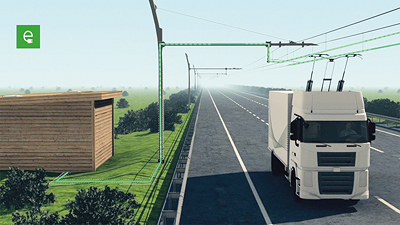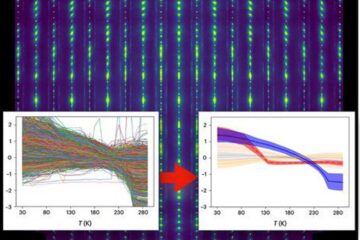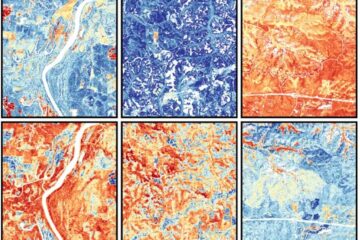Siemens tests eHighway system in California

In the context of the research project ENUBA (Electromobility in heavy commercial vehicles to reduce the environmental impact on densely populated areas), Siemens produced an holistic concept for the electrification of HGV traffic by means catenaries and to test the technical feasibility of the system on a specially built test track in the north of Berlin, Germany.
Siemens is to conduct trials on a two-mile stretch of highway after installing a catenary system for electric and hybrid trucks in the vicinity of the largest US ports of Los Angeles and Long Beach.
The company was awarded the associated contract by Southern California's South Coast Air Quality Management District (SCAQMD). The objective is to completely eliminate local emissions such as nitrogen oxides and to reduce the consumption of fossil fuels and cut the operating costs of trucks.
The test results should be available in the summer of 2016, and will indicate the suitability of the systems for future commercial use. The ports of Los Angeles and Long Beach are seeking an emission-free solution (“Zero Emission I-710 Project”) for a section of Highway 710, which carries a high proportion of shuttle truck traffic. The 30 kilometer route links the two ocean ports and the railroad transshipment centers inland.
As part of the installation of the eHighway systems, two lanes of Alameda Street in the city of Carson, California, are being electrified via a catenary system. On the road, E-trucks equipped with hybrid drive and smart current collectors will be supplied with electricity from catenaries, offering local zero-emission operation.
In conjunction with vehicle manufacturer Mack, a member of the Volvo Group, and local truck conversion specialists, Siemens is developing up to four demonstration vehicles. The smart current collectors permit overtaking maneuvers and automatic hook-up and disconnection at speeds up to 90 km/h. On normal roads without overhead lines the vehicles make use of a hybrid system which can be operated alternatively with diesel, compressed natural gas or via a battery.
“Our highway technology eliminates local emissions and is an economically attractive solution for freight transport on shuttle truck routes,” says Matthias Schlelein, head of Siemens Division Mobility and Logistics in the USA. “Long Beach and Los Angeles, the two US ports generating the most traffic, can benefit hugely from our technology.”
“This project will help us evaluate the feasibility of a zero-emission cargo movement system using overhead catenaries,” said Barry Wallerstein, SCAQMD's executive officer. “Southern California's air pollution is so severe that it needs, among other strategies, zero- and near-zero emission goods movement technologies to achieve clean air standards.”
“I'm happy to see the Los Angeles region leading the way in bringing cutting edge technology to an increasingly important economic center,” said Los Angeles Councilman Joe Buscaino. “The eHighway project is a great example of how electricity can help power the next generation of transportation systems while also providing cleaner air for our citizens in the process.”
Further info, along with photo and video material may be found at: https://www.siemens.com/press/ENUBA-2
The Siemens Infrastructure & Cities Sector (Munich, Germany), with approximately 90,000 employees, focuses on sustainable and intelligent infrastructure technologies. Its offering includes products, systems and solutions for intelligent traffic management, rail-bound transportation, smart grids, power distribution, energy efficient buildings, and safety and security. The Sector comprises the divisions Building Technologies, Low and Medium Voltage, Mobility and Logistics, Rail Systems and Smart Grid. For more information visit http://www.siemens.com/infrastructure-cities
The Siemens Mobility and Logistics Division (Munich, Germany) is a leading international provider of integrated technologies that enable people and goods to be transported in an efficient, safe and environmentally-friendly manner. The areas covered include rail automation, intelligent traffic and transportation systems, and logistics solutions for airports, postal and parcel business. Through its portfolio the Division combines innovations with comprehensive industry know-how in its products, services and IT-based solutions. Further information can be found at http://www.siemens.com/mobility-logistics/
Reference Number: ICMOL20140812e
Contact
Ms. Silke Reh
Mobility and Logistics Division
Siemens AG
Otto-Hahn-Ring 6
81739 Munich
Germany
Tel: +49 (89) 636-630368
Media Contact
All latest news from the category: Ecology, The Environment and Conservation
This complex theme deals primarily with interactions between organisms and the environmental factors that impact them, but to a greater extent between individual inanimate environmental factors.
innovations-report offers informative reports and articles on topics such as climate protection, landscape conservation, ecological systems, wildlife and nature parks and ecosystem efficiency and balance.
Newest articles

Machine learning algorithm reveals long-theorized glass phase in crystal
Scientists have found evidence of an elusive, glassy phase of matter that emerges when a crystal’s perfect internal pattern is disrupted. X-ray technology and machine learning converge to shed light…

Mapping plant functional diversity from space
HKU ecologists revolutionize ecosystem monitoring with novel field-satellite integration. An international team of researchers, led by Professor Jin WU from the School of Biological Sciences at The University of Hong…

Inverters with constant full load capability
…enable an increase in the performance of electric drives. Overheating components significantly limit the performance of drivetrains in electric vehicles. Inverters in particular are subject to a high thermal load,…





















